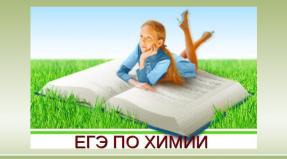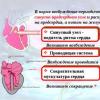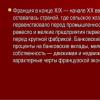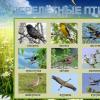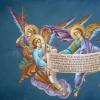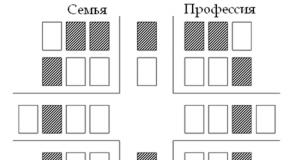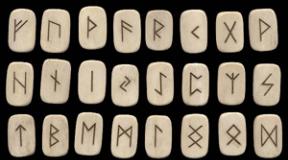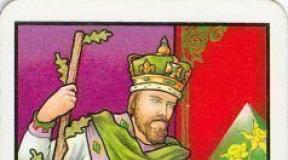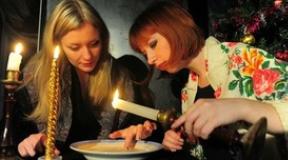Great medical encyclopedia. Human structure. Bones of the torso What limits the soul and body
The trunk skeleton (Fig. 11) consists of a spinal column, chest and is part of the axial skeleton.
Rice. eleven.
(front view):
1 - skull; 2 - spinal column; 3 - clavicle; 4 - rib; 5 - sternum; 6- brachial bone; 7- radius bone; 8- ulna; 9- wrist bones; 10 - metacarpal bones; 11- phalanges of the fingers; 12 - the ilium; 13 - sacrum; 14 - pubic bone; / 5 - ischium; 16 - thigh bone; 17- patella; 18 - tibia; 19- fibula; 20- bones of the tarsus; 21- metatarsal bones; 22 - phalanges of toes
The vertebrae in different parts of the spinal column have not only common features and structure, but also characteristic features associated with vertical position person.
The vertebra (vertebra) consists of a body (corpus vertebrae) and an arch (arcus vertebrae), which, closing, forms a vertebral foramen (foramen vertebrale). When all the vertebrae are connected, a spinal canal (canalis vertebralis) is formed, in which spinal cord... Two upper and two lower articular processes, the right and left transverse processes, depart from the arch of the vertebra. Behind, along the midline, the spinous process departs. At the junction of the arch and the vertebral body are the upper and lower vertebral notches, which, when the vertebrae are connected, form an intervertebral foramen (foramen intervertebrale). They pass through this hole blood vessels and the spinal nerve.
Cervical vertebrae (vertebrae cervicales) differ from the vertebrae of other departments (Fig. 12). Their bodies are small and elliptical. Their main difference is the presence of a hole in the transverse process. The first two vertebrae are involved in the movement of the head and are connected to the skull (this is how they differ from other cervical vertebrae).

1 - upper articular process; 2 - arch of the vertebra; 3 - vertebral foramen; 4 - spinous process; 5 - plate of the vertebral arch; 6 - lower articular process; 7-posterior tubercle; 8- groove of the spinal nerve; 9 - opening of the transverse process; 10 - anterior tubercle; 11- vertebral body; 12 - body hook; 13- transverse process
Under the influence of the increasing load, the bodies of the cervical vertebrae increase from III to VII vertebra. The spinous processes of the cervical vertebrae are bifurcated, except for VII, which is much longer than the others and is easily palpable under the skin. The anterior tubercle of the VI cervical vertebra is better developed than in other vertebrae. The carotid artery passes close to it, therefore it is called the carotid tubercle. To temporarily stop the bleeding, the carotid artery is clamped at this point.
The thoracic vertebrae (vertebrae thoracicae) are larger than the cervical vertebrae (Fig. 13). Their vertebral foramen are somewhat smaller than those of the cervical, on the lateral surfaces of the body are the upper and lower costal fossa, which are necessary for the formation of joints with the heads of the ribs. The height of the bodies of the thoracic vertebrae (from I to XII) gradually increases. The spinous processes are somewhat longer, directed posteriorly and downward, overlaid in tiles one by one and limit the mobility of this spine (especially extension).

1 - the leg of the vertebral arch; 2- upper vertebral notch; 3, 7 - transverse process; 4- superior articular process; 5.9 - superior costal fossa; 6- vertebral canal; 8 - spinous process; 10 - costal fossa of the transverse process; 11 - lower articular process; 12- lower vertebral notch; 13, 14 - lower costal fossa; 15 - vertebral body
Lumbar vertebrae (vertebrae lumbales) have a more massive body than other vertebrae (Fig. 14).

Rice. fourteen.
(view from above):
1 - spinous process; 2 - upper articular process; 3 - costal process; 4 - arch of the vertebra; 5 - vertebral foramen; 6- leg of the vertebral arch; 7- vertebral body; 8- accessory process; 9 - mastoid process
The body of the lumbar vertebra is bean-shaped, its transverse size is larger than the anteroposterior one. The body of the V lumbar vertebra is the largest in height and width. The spinous processes are massive and directed backward almost horizontally, and the articular processes are sagittal. This gives significant mobility to the lumbar spine. The vertebral foramen, which is larger than in other parts, is triangular in shape, with rounded edges.
The sacral vertebrae (vertebrae sacrales), connecting with each other, form a single bone - the sacrum (os sacrum). The sacrum (Fig. 15) has the shape of a triangle, the base of which is connected to the V lumbar vertebra, and the apex is directed downward and forward.

Rice. 15.
(front view):
1 - the base of the sacrum; 2 - upper articular process; 3 - the anterior surface of the sacrum; 4 - transverse lines; 5- apex of the sacrum; b - anterior sacral foramen; 7- cape; 8 - lateral part
On the concave anterior pelvic surface there are four transverse lines, which are traces of the fusion of the bodies of the sacral vertebrae. On the convex (dorsal) surface, longitudinal sacral rowing
Neither (median, intermediate and lateral). On both sides of the surfaces of the sacrum, there are four pairs of sacral openings, through which branches of the spinal nerves exit from the sacral canal. The massive lateral portions have an ear-shaped surface intended for connection to the corresponding articular surfaces pelvic bones... The junction of the sacrum with the V lumbar vertebra is a forward-directed protrusion - a promontorium. The apex of the sacrum connects to the tailbone.
The coccyx (os coccygis) consists of 1-5 (usually 4) accrete rudimentary vertebrae vertebrae coccygeae (Fig. 16). It has the shape of a triangle, curved forward, its base is directed forward and upward, and its top is directed downward and forward. Some signs of a vertebra are observed only in the 1st coccygeal vertebra, the rest are much smaller in size and rounded.

Fig 16
(back view)
1- tailbone; 2-coccygeal horn
Rib (costa), 12 pairs, consists of a long posterior bony part and a short middle cartilaginous part (costal cartilage). Seven pairs of upper ribs (I-VII) are connected by cartilaginous parts to the sternum and are called true. Cartilage VIII, IX, X pairs of ribs are connected not with the sternum, but with the cartilage of the overlying rib, such ribs are called false. Ribs XI and XII have short cartilaginous parts that end in the muscles of the abdominal wall. They are more mobile and are called oscillating.
The rib has a head, body and neck. Between the neck and the body in the upper 10 pairs of ribs there is a tubercle, ribs. At the rib, an inner and outer surface, an upper and lower edge are distinguished. On the inner surface of the rib, along its lower edge, there is a groove - the place where the intercostal vessels and nerve pass. On outer surface ribs between the body and the neck of the rib there is a tubercle of the rib, the articular surface of which articulates with the transverse process of the vertebra.
Ribs vary in shape and size (Fig. 17, 18). The shortest are two upper and two lower ribs. The first rib lies horizontally, on its upper surface there is a small tubercle for attaching the anterior scalene muscle and two grooves: the anterior one for subclavian vein, posterior - for the subclavian artery.

Rice. eighteen.
(inner surface):
1 - articular surface of the rib head; 2 - articular surface of the rib tubercle;
3 - rib tubercle; 4 - rib neck; 5 - rib angle; 6 - rib body
The sternum (sternum) is an oblong flat bone, which consists of three parts: the handle, the body and the xiphoid process. In adults, all parts grow together into a single bone. On the upper edge of the sternum handle are the jugular notch and the paired clavicular notches. On the front surface of the body of the sternum and along its edges, there are costal notches.
The xiphoid process may have different shape and the size is sometimes bifurcated.
The vertebral column (columns vertebralis) performs a supporting function, connects parts of the human body, and also performs a protective function for the spinal cord and the roots of the spinal nerves leaving the spinal column. The human vertebral column consists of 33-34 vertebrae. The last 6-9 vertebrae grow together and form the sacrum and coccyx (Fig. 19).
The spine is divided into five sections: cervical - consists of 7 vertebrae; chest - out of 12; lumbar - out of 5; sacral - from 5 and coccygeal - from 2-5 vertebrae.
The human spinal column is characterized by the presence of bends. The bulge directed forward is called lordosis (cervical and lumbar), and the bulge directed backward is called kyphosis (thoracic and sacral). At the site of the transition of the cervical lordosis into the thoracic kyphosis there is a protruding VII cervical vertebra. At the border of lumbar lordosis with sacral kyphosis, a forward facing sacrum promontory forms. The bends of the spinal column (lordosis and kyphosis) perform spring and amortization functions when walking, running and jumping. As a result of a violation of symmetry in the development of the muscle mass of the human body, a pathological (lateral) bending also appears - scoliosis.
1 - cervical vertebrae; 2 - thoracic vertebrae; 3 - lumbar vertebrae; 4- sacrum; 5- tailbone
The thorax (compages thoracis) is formed with the help of the thoracic spine, ribs, sternum and articular joints, restricting the chest cavity, where the main human organs are located: the heart, lungs, blood vessels, trachea, esophagus and nerves (Fig. 20).

Vertebrae
rice. 8. Eighth (VIII) thoracic vertebra (vertebra thoracica VIII), top view.Arch of the vertebra, arcus vertebra (vertebralis), limits the back and sides of the vertebral foramen, foramen vertebrate; located one above the other, the holes form the spinal canal, canalis vertebralis in which the spinal cord lies. From the posterolateral edges of the vertebral body, the arc begins with a narrowed segment - this is the leg of the vertebral arch, pediculus arcus vertebrae, vertebralis passing into the plate of the vertebral arch, lamina arcus vertebrae (vertebralis)... There is an upper vertebral notch on the upper and lower surfaces of the pedicle, incisura vertebralis superior, and the lower vertebral notch, incisura vertebralis inferior... The upper notch of one vertebra, adjacent to the lower notch of the upper vertebra, forms an intervertebral foramen (foramen intervertebrale) for the passage of the spinal nerve and vessels.
Processes of the vertebra, processus vertebrae, seven in number, protrude on the vertebral arch. One of them, unpaired, is directed from the middle of the arch posteriorly - this is the spinous process, processus spinosus... The rest of the processes are paired. One pair - superior articular processes, processus articulares superiores, located on the side of the upper surface of the arch, the other pair - the lower articular processes, processus articulares inferiores, protrudes from the side of the lower surface of the arc and the third pair are transverse processes, processus transversi, departs from the side of the side surfaces of the arc.
There are articular surfaces on the articular processes, facies articulares... To these surfaces, each overlying vertebra articulates with the underlying one.
- Vertebral column, columna vertebralis. Rice. A. la. Vertebra, vertebra.
- The vertebral canal, canalis vertebralis. Formed by the vertebral foramen. Contains the spinal cord. Rice. B.
- Vertebral body, corpus vertebrae (vertebrale). Rice. B, C, G. For. Intervertebral surface, fades intervertebralis. The surface of the vertebral body facing the adjacent vertebra. Rice. B. 36. Annular apophysis (pineal gland), apophysis anularis. A ring-shaped bony protrusion located on the upper and lower surfaces of the vertebral body. It is a secondary center of ossification. Rice. B.
- Arch of the vertebra, arcus vertebrae (vertebralis). Restricts the vertebral foramen from behind and from the sides. Rice. B, G.
- The pedicle of the vertebral arch, redieulus arcus vertebrae. Part of the arch between the body and the transverse process. Rice. B, G.
- Vertebral arch plate, lamina arcus vertebrae (vertebralis). Part of the arc between the transverse and spinous processes. Rice. B. 6a. Neurocentral junction neurocentralis. It is located between the centers of ossification in the neural arches and the vertebral body. Detected in fetuses and children early age... Rice. G.
- Intervertebral foramen, foramen intervertebral. Limited to the upper and lower vertebral notches, the vertebral body, and the intervertebral disc. Contains the spinal nerve and small vessels. Rice. A, B.
- Upper vertebral notch, incisura vertebralis superior. Notch on the upper edge of the pedicle of the vertebral arch. Rice. B.
- Lower vertebral notch, incisura vertebralis inferior. Notch at the lower edge of the pedicle of the vertebral arch. Rice. B.
- Vertebral foramen, foramen vertebrate. Limited by the arch and the vertebral body. The openings of all vertebrae make up the spinal canal. Rice. B, G.
- Spinous process, processus spinosus. In 2 - 4 cervical vertebrae, the spinous processes are bifurcated. Rice. B, C, G.
- Transverse process, processus transversa. Rice E.
- Costal process, processus costalis. Transverse process of the lumbar vertebra. Analogue of a rudimentary rib. Rice. G.
- Superior articular process, processus articularis (zygapophysis) superior. Located on the arch of the vertebrae, directed upwards. Rice. B, C, G.
- Inferior articular process, processus articularis (zygapophysis) inferior. Located on the arch of the vertebrae and directed downward. Rice. B, C.
- Cervical vertebrae, vertebrae cervicales. The cervical spine includes seven vertebrae (C1 - C7). Rice. A.
- Hook of the body, uncus corporis. An upwardly directed uncinate process located along the lateral edge of the cervical vertebral bodies. Bone proliferation in this area can compress the spinal nerve. Rice. V.
- The opening of the transverse process, foramen tram. ersarium. Located in the transverse processes of the cervical vertebrae. Contains vertebral artery and vein. Rice. V.
- Anterior tubercle, tuberculum anterius. The eminence on the transverse processes C2-7, directed forward, which serves as the attachment point for the mouse. Rice. V.
- Back tubercle, tuberculum posterius. The elevation on the transverse processes C2-7, directed backward, which serves as the site of muscle attachment. Rice. V.
- Sleepy tubercle, tuberculum caroticum. Anterior tubercle Sat. Rice. A.
- Spinal nerve groove, sulcus n.spinalis. Located on the transverse processes of the SZ-7. The spinal nerve passes through it. Rice. V.
- Protruding vertebra, vertebra prominens (SP). The seventh cervical vertebra, which has the longest spinous process (in 70% of cases). Rice. A.
- Thoracic vertebrae, vertebrae thoracicae. The thoracic spine includes twelve vertebrae (T1 - 12). Rice. A.
- Superior costal fossa, fovea costalis superior. It is located on the vertebral body above the pedicle of the arch. Serves for articulation with the head of the rib. Rice. B.
- Lower costal fossa, fovea costalis inferior. Located on the vertebral body below the pedicle of the arch. Serves for articulation with the rib head. Rice. B.
- Costal fossa of the transverse process, fovea costalis processus transversi. Articular surface for articulation with the tubercle of the rib, located on the transverse process of the vertebra. Rice. B.
- Lumbar vertebrae, vertebrae lumbales (lumbares). Part lumbar the vertebral column includes five vertebrae (L1 - 5). Rice. A.
- Accessory process, processus accessorius (vertebrarum lumbalium). Rudiment of the transverse process of the lumbar vertebrae. It departs from the base of the costal process and is directed backward. Rice. G.
- Mastoid process, processus mamillaris. Rudimentary process of the lumbar vertebrae. It departs from the posterior edge of the superior articular process and is directed backward. Rice. G.
The vertebra, vertebra, has a body, an arch and processes. The vertebral body, corpus vertebrae, represents the anterior, thickened, part of the vertebra, it is bounded above and below by surfaces facing the above- and lower-lying vertebrae, respectively, in front and on the sides - a slightly concave surface, and in the back - flattened. On the vertebral body, especially on its posterior surface, there are many nutrient holes, foramina nutricia - traces of the passage of blood vessels and nerves into the bone substance
The vertebra, vertebra, has a body, an arch and processes. Vertebral body,
corpus vertebrae , represents the anterior, thickened, part of the vertebra, it is bounded from above and below by surfaces facing, respectively, the higher and lower vertebrae, from the front and from the sides - a somewhat concave surface, and from the back - by a flattened one. On the vertebral body, especially on its posterior surface, there are many nutrient holes, foramina nutricia - traces of the passage of blood vessels and nerves into the bone substance. The vertebral bodies are interconnected by intervertebral discs(cartilage) and form a very flexible column - the spinal column. Arch of the vertebra, arcus vertebrae , limits the back and sides of the vertebral foramen, foramen vertebrale ; located one above the other, the holes form the spinal canal, canalis vertebralis, in which the spinal cord lies. From the posterolateral edges of the vertebral body, the arch begins with a narrowed segment - the leg of the vertebral arch, pedunculus arcus vertebrae ... There is an upper vertebral notch on the upper and lower surfaces of the pedicle, incisura vertebralis superior , and the lower vertebral notch, incisura vertebralis inferior ... The upper notch of one vertebra, adjacent to the lower notch of the overlying vertebra, forms the intervertebral foramen, foramen intervertebrale through which the spinal nerve and blood vessels pass. The processes of the vertebra, processus vertebrae, a total of 7, protrude on the arch of the vertebra. One of them, unpaired, is directed from the middle of the arch posteriorly and is called the spinous process, processus spinosus ... The rest of the processes are paired. One pair - superior articular processes, processus articulares superiores , located on the side of the upper surface of the arch, the other pair - the lower articular processes, processus articularis inferiores , protrudes from the side of the lower surface of the arc and the third pair are transverse processes, processus transversus , departs from the side of the side surfaces of the arc. The upper articular processes have upper articular surfaces, facies articulares superiores ; on the lower articular processes are the same lower articular surfaces, facies articulares inferiores ... With these surfaces, each overlying vertebra articulates with the underlying vertebra.Each person is endowed with a soul and a body. Even inveterate materialists do not deny that in man there is something inexplicable by science, some kind of superpowers. They can be called "superconsciousness", "intuition" or "higher instinct", explained by the activity of the brain, sensitivity to certain energy fields, or simply the "inner nature" of a person. We will call it the soul and try to figure out how it is connected with our body, how they function and develop, what and how they differ.
The human soul begins its formation at the moment of the inception of human life. We can say that the sperm and the egg, in addition to physical form, have some kind of energy, which is combined with the eternal Divine energy gives rise to new eternal life. While a person's body develops in the womb, his spirit is also formed with him. The moment of a person's birth, his first breath is the moment of joining his formed body and soul. From this moment begins the stage of earthly life and the time for physical and spiritual growth and maturation.
The soul and body of a person are his inner and outer nature. We can say that in terms of external characteristics, they are completely identical. People who are able to see with spiritual sight can clearly describe both facial features and some external features spiritual self. Psychics can, by the outward appearance of a person's soul, clearly determine which body organs are out of order. For example, if in the spiritual form of a person at the location of his stomach there is dark spot, then this may indicate serious problems with the physical organ - the stomach.
The soul and body need certain elements for their growth and development. Our body needs light and air to grow and develop. Moreover, both light and air must have strictly defined parameters. Only sunlight is suitable for the ideal development of a person. We, of course, can withstand some time under the light of an electric lamp or a candle, but such a life can no longer be called full. The same applies to air, which must have a strictly defined composition - oxygen, nitrogen, hydrogen, and other elements in certain proportions. Only under this condition will we be able to fully live and develop on earth. This is how our body is programmed.
Our soul is also "programmed" to receive certain elements for its full development. The "air" for our soul is the love of God. Just as a person strives from a stuffy room to clean mountain air, we strive with all our souls and strive for clean air. This is already inherent in every person, none of us will rest, and will never feel completely satisfied without God. No other love will ever replace the "air" for which our "spiritual lungs" are created. The same applies to the light that our soul needs - Divine truth. We can choose what we want to believe, we can follow some certain philosophies, but our soul will always seek a connection with God and His bright sunlight. This is how it was created.
In addition to light and air, both the soul and the body need nourishment. A person receives physical energy when he eats plants and animals, and also drinks water. Likewise, a person receives spiritual energy when he reads books, listens to music, and does something he loves. What a person feeds and fills his body and soul with is his personal responsibility. However, do not forget that nutrition directly affects health and quality of life. This applies both to the body of a person and to his soul. Unhealthy food and bad habits lead to the emergence and development of many diseases and deprive a person of vitality, like this unhealthy hobbies, vulgarity, watching pornography, dirty words and expressions - all this is a poison that poisons the soul.
And they directly affect each other, since they exchange certain elements with each other. This happens constantly and continuously. Our soul transfers to the body spiritual elements that fill our body with special spiritual energy and strength. Each of us has experienced moments of inspiration and joy when it seems that the body is just floating in the air. Then we can handle any task. Sleep, food, physical pleasures fade into the background, and we become supermen for a short time. This usually happens when we are doing something good for other people. The reason for this lies in the fact that our body at the moment of action produces a certain "vital" element, which is transmitted to our soul.
Positive vital elements give positive energy to our soul, and in return it fills our body with a positive “spiritual” element, which in turn fills us with joy and inspiration and is even capable of healing diseases. Negative vital elements - when we do selfish deeds - transmit negative energy to our soul. Accordingly, having received such negative energy, the soul transfers a negative spiritual element to our body. Then we begin to overwhelm with feelings of despair, depression, and our strengths gradually disappear somewhere.
Despite the fact that the soul and body are formed at the same time and develop together for some time, the moment comes when they will have to separate forever. The human body has its own definite time and space, while the soul exists outside of these concepts. The responsibility of man is to develop his soul in the allotted time and prepare it for life in eternity. Just as a baby in the womb forms its physical organs, the soul of a person during his earthly life develops its "spiritual organs" necessary for him. And if people really care about their own appearance, our health, which are largely genetically inherent and eventually disappear anyway, how much more should we take care of our eternal spiritual "appearance" and spiritual "health", which directly depend on us and will accompany our eternal physical body.
Read also ...
- Valentines: a big history of small postcards
- Sketch study of the basic version of the nightgown
- Presentation for the orkse lesson for primary grades "monastery"
- Presentation on the theme "development of a system of motivation and incentives for labor" Incentives and motivation of personnel labor presentation

